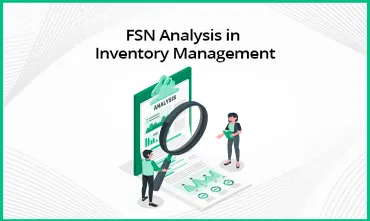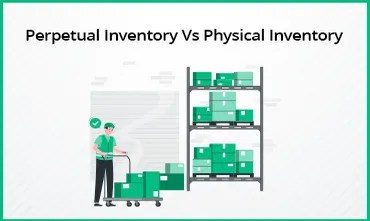FSN Analysis in inventory management is important for maintaining business performance and profit, especially in manufacturing. FSN Analysis means fast, slow, and non-moving goods. This grouping of items helps the manufacturers calculate the movement of each inventory item.
FSN Analysis offers valuable information into improving stock levels and day-to-day operations. In this article, we will see how the FSN Analysis allows manufacturing businesses to make informed decisions, reduce waste, and increase productivity in their inventory management processes.
What is FSN Analysis?
FSN analysis is the short form for Fast-moving, Slow-moving, and Non-moving inventory. It is a method widely used by manufacturing and other businesses to control their inventory properly. It arranges items within the inventory reports based on their movement rate.
- The fast inventory contains products that quickly sell out and require regular restocking.
- Slow inventory includes items with low sales rates. These items have a low reorder rate.
- Non-moving inventory includes products that do not sell at all or have very limited sales. This category includes deadstock. It often requires disposal.
The primary aim of FSN inventory analysis is to reduce material, labour, and turnover costs. Factors included in this analysis are:
- Consumption rate: This is the percentage rate at which stocks are used up or replenished within a given period.
- Average stay in inventory: It is the average time each item remains in inventory before being sold.
- Period of analysis: Period of analysis provides the correct time for inventory review, such as six months or a year.
How Does FSN Analysis Work?
FSN analysis works by dividing inventory into fast-moving, slow-moving, and non-moving items based on their sale rate. Fast-moving items sell quickly and need regular restocking. Slow-moving items have lower turnover rates. Lastly, non-moving items usually sell very slowly or not at all. Different manufacturing businesses can adjust their management strategies by arranging inventory this way.
What Is the FSN Method of Inventory Control?
FSN in inventory management is a technique that puts the inventory items into three groups based on their purchase rate, quantity, and how often they are used:
- F: Fast-moving
- S: Slow-moving
- N: Non-moving
Overall, the FSN method of inventory control helps businesses make decisions about their stock levels, order quantities, and inventory carrying costs. This helps improve the manufacturing process and helps decide what products should be manufactured first and what products are not selling at all.
Importance and Usage of FSN Analysis
FSN analysis holds great importance and is widely used by manufacturing businesses for many reasons:
Improved Inventory Levels:
FSN analysis helps different businesses maintain the right inventory levels by grouping items based on their sales rate. This makes sure that fast-moving items are properly stocked to prevent stockouts. In addition, slow-moving items are managed correctly to avoid overstocking.
Cost Reduction:
By identifying slow-moving and non-moving inventory, manufacturing businesses can develop strategies to reduce holding costs linked with unused inventory. This may include removing non-moving items, running promotions for slow-moving items, or improving inventory turnover for better capital management.
Improved Cash Flow:
Proper inventory management through FSN analysis helps improve cash flow. This helps manufacturers to reduce extra inventory and focus on fast-moving items. In this way, businesses can free up capital that can be invested in other areas like advertising, raw materials, etc.
Customer Satisfaction:
Maintaining the right stock levels makes sure that customers have access to the products they need the most. This results in improved customer satisfaction and loyalty. It also contributes to repeat business and positive publicity.
How to conduct FSN analysis?
Conducting FSN analysis of inventory control is important for proper inventory management, order fulfilment, and cost control. Here's a step-by-step guide to conducting FSN analysis:
- Prepare a list of inventory items and collect data on annual demands, unit prices, and annual sales rates for each product.
- Arrange available inventory items in descending order based on their annual usage.
- Calculate the percentage of annual usage and the average total storage time for each inventory item.
- Group inventory items into fast-moving (F), slow-moving (S), and non-moving (N) categories based on their total percentage of annual demand.
To conduct FSN analysis successfully, collect the following data:
- Name of the item
- Turnover ratio (annual demand divided by annual inventory)
- Annual demand for each item
- Unit price of each product
- Annual usage of each item
- Total/Cumulative consumption rate of each product
Calculate annual usage for each item using the formula:
Annual Usage = Annual Demand * Unit Price
Calculate cumulative percentage usage for each item using the formula:
Cumulative Percentage Usage = Cumulative Percentage of Previous Item + Annual Percentage Usage of Current Item
After these calculations, divide inventory products into fast-moving, slow-moving, and non-moving categories based on their sales rates. Typically, fast-moving items account for 70% of annual sales, slow-moving items for 20%, and non-moving items for 10%.
Benefits of FSN Analysis in Inventory Management
Using FSN inventory management techniques offers multiple advantages. Some of these benefits include:
1. Profit Boost
With the help of inventory level monitoring and cost reduction measures like reducing holding costs, controlling transportation costs, etc., businesses can increase their profits.
2. Decrease in Inventory Cost
By grouping slow-moving and non-moving items, manufacturers can cut down on inventory carrying costs.
3. Customer Satisfaction
Maintaining the right stock levels of fast-moving items helps avoid stockouts. It helps businesses meet customer demand easily and quickly.
Advantages of FSN Analysis
FSN analysis of inventory control has many advantages. Let’s have a look at some of those advantages below:
- FSN classification lets you make informed decisions about which products to restock frequently. It also tells you which ones cost you money by sitting on the shelf in your warehouse.
- FSN analysis helps identify deadstock. It prevents you from stocking products with low demand, thus avoiding extra inventory costs.
- FSN analysis is helpful in budgeting for specific products and calculating the correct quantity to purchase. It prevents tying up capital in slow-moving or non-moving goods.
- FSN analysis helps you study market trends. This helps you to adapt your inventory accordingly to meet changing demands.
Disadvantages of FSN analysis
Below are a few of the disadvantages that the FSN technique of inventory control has:
- FSN analysis depends heavily on accurate data and formulas. If the information used is incorrect or incomplete, it can lead to a false analysis. Later, it can affect business inventory management decisions.
- Fast changes in market trends can affect the accuracy of FSN analysis. For example, sudden changes in demand for a product may cause previously calculated restocking schedules to be useless. It can, therefore, lead to inventory mismatches.
Perform Correct FSN Analysis in Inventory Management With TranZact
TranZact is a tool made for small and medium manufacturing businesses to help them go digital in their operations. Using TranZact for FSN analysis in inventory management allows manufacturing businesses to perform detailed and timely inventory analysis.
By using TranZact's features, manufacturers can easily arrange and manage their inventory. It will help you make informed decisions and improve the stock levels based on the right data. This partnership increases operational efficiency, reduces costs, and improves inventory management processes. Ultimately, it contributes to increased sales and customer satisfaction.
FAQs on FSN Analysis in Inventory Management
1. What is FSN analysis, and how is it used in inventory management?
FSN analysis is a method used in inventory management to sort items within the warehouse based on their movement rate. It helps identify fast-moving, slow-moving, and non-moving items. It helps businesses to make informed decisions about stock levels, procurement, and storage methods.
2. How does FSN analysis categorize inventory items?
FSN analysis categorizes inventory items into three groups:
- F (Fast-moving): Items that have a high turnover rate and are frequently sold or used.
- S (Slow-moving): Items with a low turnover rate are sold or used less frequently.
- N (Non-moving): Items that have little or no movement, remaining in inventory for a long time without being sold or used.
3. How is FSN calculated?
FSN is calculated by examining historical sales or consumer data for each inventory item over a specific period. The movement rate affects the item's categorization as fast-moving, slow-moving, or non-moving.
4. What is the purpose of FSN analysis?
The primary purpose of FSN analysis is to improve inventory management. It helps provide appropriate stock levels, reduce carrying costs, prevent stockouts, and improve overall operational performance.
5. What are the key factors considered in FSN analysis of inventory control management?
Key factors considered in FSN analysis include:
- Sales or usage frequency
- Lead times for procurement
- Holding costs
- Market demand changes
- Seasonal effects
6. What are the techniques of inventory control?
Techniques of inventory control include:
- ABC analysis
- Just-in-time (JIT) inventory
- Economic order quantity (EOQ)
- Vendor-managed inventory (VMI)
- Batch tracking and serial numbering
7. What is the analysis method of inventory control?
The analysis methods in inventory control involve:
- Historical sales data analysis
- Demand forecasting
- Inventory turnover ratio calculation
- Inventory management modelling
8. What is an example of a fast-moving inventory?
Fast-moving FSN analysis in inventory management examples include:
- perishable goods like fresh produce in a grocery store
- popular electronics like smartphones, or
- frequently used office supplies like printer paper.
9. What is an example of a non-moving inventory?
Examples of non-moving inventory can include obsolete products, seasonal items that didn't sell, or specialized equipment with low demand.
10. How do you manage fast-moving inventory?
You can manage fast-moving inventory:
- By having enough stock levels to meet demand.
- By using efficient replenishment strategies
- By regularly monitoring sales trends and adjusting inventory levels accordingly
11. What is SDE in inventory control?
SDE analysis of inventory control stands for Stock, Demand, and Expectation. SDE analysis in inventory management refers to reviewing current stock levels, forecasting demand, and setting targets for future inventory requirements.
12. What is FNSD analysis in cost accounting?
FNSD analysis in cost accounting stands for Fast-moving, Non-moving, Slow-moving, and Deadstock analysis. It's a method of grouping inventory items based on their movement rates. It helps find obsolete or dead stock that should be removed from inventory to reduce costs.












